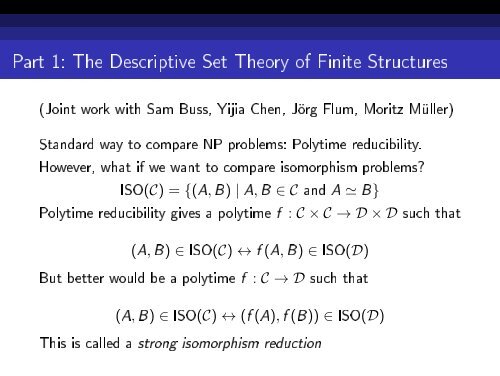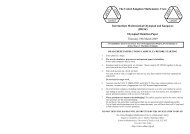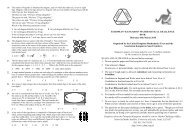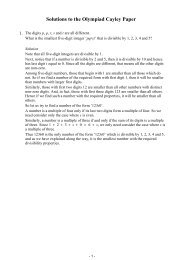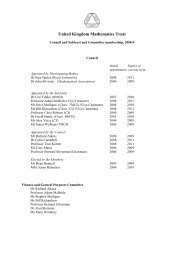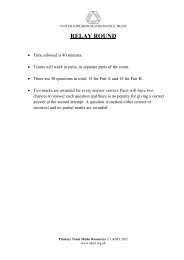Part 1: The Descriptive Set Theory of Finite Structures
Part 1: The Descriptive Set Theory of Finite Structures
Part 1: The Descriptive Set Theory of Finite Structures
Create successful ePaper yourself
Turn your PDF publications into a flip-book with our unique Google optimized e-Paper software.
<strong>Part</strong> 1: <strong>The</strong> <strong>Descriptive</strong> <strong>Set</strong> <strong>The</strong>ory <strong>of</strong> <strong>Finite</strong> <strong>Structures</strong>(Joint work with Sam Buss, Yijia Chen, Jörg Flum, Moritz Müller)Standard way to compare NP problems: Polytime reducibility.However, what if we want to compare isomorphism problems?ISO(C) = {(A, B) | A, B ∈ C and A ≃ B}Polytime reducibility gives a polytime f : C × C → D × D such that(A, B) ∈ ISO(C) ↔ f (A, B) ∈ ISO(D)But better would be a polytime f : C → D such that(A, B) ∈ ISO(C) ↔ (f (A), f (B)) ∈ ISO(D)This is called a strong isomorphism reduction
Strong Isomorphism Reductions in Complexity <strong>The</strong>oryIn general: For binary relations E, F on classes C, D we dene astrong equivalence reduction to be a polytime f : C → D such thatA E B ↔ f (A) F f (B)This is the nitary analog <strong>of</strong> the similar theory for countablestructures, the <strong>Descriptive</strong> <strong>Set</strong> <strong>The</strong>ory <strong>of</strong> Equivalence Relations (bigliterature)Summary:1. Even if P = NP there is a rich structure to strong isomorphismreducibility.2. <strong>The</strong> ner questions about strong isomorphism reducibility areclosely connected with deep open problems in complexity theory.
Invariant Polytime ClassesFix a nite vocabulary (relation, function and constant symbols)Consider structures for this vocabulary with universe[n] = {1, ..., n} for some nite n. (We allow the empty structure.)<strong>Structures</strong> can be identied with 0, 1-strings <strong>of</strong> length a xedpolynomial in n<strong>The</strong> number <strong>of</strong> structures <strong>of</strong> size n is exponential in nA class C <strong>of</strong> structures is invariant i it is closed underisomorphism: A ∈ C, A ≃ B → B ∈ C(∗) We consider polytime, invariant classes with structures <strong>of</strong>arbitrarily large nite size
Invariant Polytime ClassesExamples:SET (Empty vocabulary)FIELD (Fields)ABELIAN (Abelian groups)CYCLIC (Cyclic groups)ORD (Linear orders)LOP (Linear orders with a distinguished point)BOOLE (Boolean algebras)GROUP (Groups)LOU (Linear orders with a unary relation)GRAPH (Irreexive binary relations)
Strong Isomorphism ReductionsIf C, D are polytime classes then we write: C ≤ iso D ithere is a polytime f : C → D such that A ≃ B ↔ f (A) ≃ f (B)We say that f is a strong isomorphism reduction from C to DA strong isomorphism degree is an equivalence class under theequivalence relation (C ≤ iso D and D ≤ iso C)C ≤ iso D is stronger than "ISO(C) is polytime reducible toISO(D)".Indeed, there are many distinct strong isomorphism degrees <strong>of</strong>classes C with ISO(C) in P
Strong Isomorphism ReductionsRecall that we assume that all <strong>of</strong> our classes are in P (and thereforeall isomorphism relations are in NP)PropositionC ≤ iso GRAPH for all C.Pro<strong>of</strong> Idea: Arbitrary structures can be coded as graphs.Also not dicult:PropositionSET, FIELD, ABELIAN, CYCLIC, ORD and LOP all have the samestrong isomorphism degree. BOOLE is strong isomorphismreducible to them.But how do we show that a class C is NOT strong isomorphismreducible to another class D?
Potential Reducibility<strong>The</strong> strong isomorphism complexity <strong>of</strong> a class is related to thenumber <strong>of</strong> isomorphism types it has in dierent cardinalitiesLet C be a class.C(n) = those structures in C <strong>of</strong> size at most n#C(n) = number <strong>of</strong> isomorphism types <strong>of</strong> structures in C(n)Examples:#BOOLE(n) = [logn]#CYCLIC(n) = n, #SET(n) = #ORD(n) = n + 1#LOP(n) = ∑ ni=1i = n · (n + 1)/2#LOU(n) = ∑ ni=0 2i = 2 n+1 − 1#GROUP(n) is superpolynomial, subexponential(#GROUP(n) ≤ n O(log 2 n) )
Potential ReducibilityFor any vocabulary there is a polynomial p such that for any class Cin that vocabulary, #C(n) ≤ 2 p(n)DenitionC is potentially reducible to D (C ≤ pot D) i there is a somepolynomial p such that #C(n) ≤ #D(p(n)) for all n.LemmaIf C ≤ iso D then C ≤ pot D.Pro<strong>of</strong>. Suppose that f is a strong isomorphism reduction. <strong>The</strong>nthere is a polynomial p such that for A in C, f (A) has size at mostp(|A|). As f induces a 1-1 map on isomorphism types, it followsthat #C(n) ≤ #D(p(n)). □
Potential ReducibilityNow one can show that there is a rich structure <strong>of</strong> strongisomorphism degrees below LOP:<strong>The</strong>orem<strong>The</strong> partial order <strong>of</strong> the countable atomless Boolean algebra isembeddable into the potential reducibility degrees below LOP. Thisembedding is also into the strong isomorphism degrees below LOP.In particular, there are innite chains and antichains in the strongisomorphism degrees below LOP.SET, FIELD, ABELIAN, CYCLIC, ORD and LOP all have the samepotential reducibility degree, as they have the same strongisomorphism degree.
Potential ReducibilityAny class is potentially reducible to LOU, as LOU has themaximum number <strong>of</strong> isomorphism classes.Corollary(a)BOOLE < iso LOP < iso LOU ≤ iso GRAPH.(b) LOP < iso GROUP < iso GRAPH.(c) LOU ≰ iso GROUP.GROUP ≤ iso LOU? GRAPH ≤ iso LOU?
Potential Reducibility versus Strong IsomorphismReducibilityDoes potential reducibility ≤ pot imply strong isomorphismreducibility ≤ iso ? We situate this question between two openquestions in complexity theory:<strong>The</strong>oremIf U2EXP ∩ co-U2EXP ≠ 2EXP then ≤ pot and ≤ iso are distinct.2EXP = DTIME(2 2nO(1) ).N2EXP = NTIME(2 2nO(1) ).U2EXP consists <strong>of</strong> those problems in N2EXP for which on everyinput there is exactly one accepting run.co-U2EXP is the complement <strong>of</strong> U2EXP.
Potential Reducibility versus Strong IsomorphismReducibility<strong>The</strong>oremIf ≤ pot and ≤ iso are distinct then P ≠ #P.For a nondeterministic polytime machine M, dene:f M (x) = the number <strong>of</strong> accepting runs <strong>of</strong> M on input x.<strong>The</strong>n the class #P consists <strong>of</strong> all such functions f M .
NP Equivalence RelationsHow do isomorphism relations compare to NP equivalence relationsas a whole?For equivalence relations E, F on classes C, D, a strong equivalencereduction is a polytime f : C → D such thatA E B ↔ f (A) F f (B)PropositionIf the Polytime Hierarchy does not collapse, then GRAPH is notmaximal among NP equivalence relations under strong equivalencereducibility.<strong>The</strong> reason is that the maximality <strong>of</strong> GRAPH would imply thatGRAPH is NP-complete in the usual sense, which is known to implythat the Polytime Hierarchy collapses.
Future WorkMore facts from Innite <strong>Descriptive</strong> <strong>Set</strong> <strong>The</strong>ory:1. Smooth → Borel selector for iso relations, not in general.2. Each closed subgroup <strong>of</strong> S ∞ is an automorphism group.3. Iso relations with classes <strong>of</strong> bounded Borel rank are Borel.4. Borel ER's with ctble classes are equivalent to iso relations.5. <strong>The</strong>re is a maximal analytic ER, no maximal Borel ERDo these have analogues for nite structures?
<strong>Part</strong> 2: Computational Complexity in <strong>Set</strong> <strong>The</strong>oryJoint work with Arnold Beckmann and Sam BussA central notion in <strong>Finite</strong> computation:Polytime functions on nite stringsHow can we generalise this notion to arbitrary sets?When is a function F : V → V computable in polynomial time?Consider some standard models for polynomial-time computation:
Polynomial-Time <strong>Set</strong> Recursion1. Turing machinesDicult to write an arbitrary set on a tape.2. Fixed point logicEven for nite structures, this works well only if there is an ordering.Moreover, on innite ordered structures, it is too powerful (it goesbeyond the hyperarithmetic).3. SchemesThis works, by generalising an idea <strong>of</strong> Bellantoni-Cook!
Bellantoni-Cook RecursionIdea behind Bellantoni-Cook recursion:Dene functionsf (⃗x/⃗y)where ⃗x,⃗y are nite sequences <strong>of</strong> nite (binary) strings and thevalues <strong>of</strong> f are nite strings<strong>The</strong> components <strong>of</strong> ⃗x are the Normal Inputs and those <strong>of</strong> ⃗y theSafe InputsWhen performing primitive recursions, the previous value is placedon the Safe side:f (0,⃗x/⃗y) = g(⃗x/⃗y)f (z ∗ i,⃗x/⃗y) = h i (z,⃗x/⃗y, f (z,⃗x/⃗y)), i = 0 or 1
Bellantoni-Cook RecursionWhen composing, one is careful not to allow safe inputs to becopied onto the normal side:f (⃗x/⃗y) = h(k(⃗x/−)/l(⃗x/⃗y))Net eect: the depth <strong>of</strong> recursions performed are bounded not bythe values obtained but by the sizes <strong>of</strong> the inputsOn normal inputs one gets exactly the polynomial-time computablefunctionsOn safe inputs string-length is increased by only a constant amount
Bellantoni-Cook RecursionA few examples (illustrated with numbers, not strings):<strong>The</strong> successor function S(x/y, z) = z + 1 is in the classAddition A(x/y) = x + y is in the class, by a primitive recursion:A(0/y) = yA(x + 1/y) = S(x/y, A(x/y)) = A(x/y) + 1A ∗ (x, y/z) = A(y/z) = y + z is also in the class<strong>The</strong>n multiplication M(x, y/−) = x × y is in the class, by a secondprimitive recursion on x:M(0, y/−) = 0M(x + 1, y/−) = A ∗ (x, y/M(x, y/−)) = y + M(x, y/−)
Bellantoni-Cook RecursionBUT exponentiation is not in the class!To run the previous argument for exponentiation one would needM ∗ (x, y/z) = M(y/z) = y × zin the class; but we only haveM(y, z/−) (multiplication <strong>of</strong> Normal Inputs)and no functionM(y/z) = y × z,which has z as a Safe Input.
<strong>The</strong> Safe-Recursive <strong>Set</strong> FunctionsWe adapt the Bellantoni-Cook idea to set theory by combining theGandy-Jensen rudimentary set functions with the set-theoreticanalogue <strong>of</strong> Bellantoni-Cook safe recursionBasic FunctionsΠ m,ni(x 1 , . . . , x m /x m+1 , . . . , x m+n ) = x i (1 ≤ i ≤ m + n)Pair(−/a, b) = {a, b}Di(−/a, b) = a \ bRudimentary Union Schemef (⃗x/⃗a, y) = ∪{g(⃗x/⃗a, z) | z ∈ y}Safe Recursionf (y,⃗x/⃗a) = h(y,⃗x/⃗a, {f (z,⃗x/⃗a) | z ∈ y})Safe Compositionf (⃗x/⃗a) = h(⃗r(⃗x/−)/⃗s(⃗x,⃗a))
<strong>The</strong> Safe-Recursive <strong>Set</strong> FunctionsSome examples <strong>of</strong> SR set functions:S(−/a) = a ∪ {a} is SRS ∗ (a/b, c) = b ∪ c is SR⊕(a/b) = {⊕(c/b) | c ∈ a} ∪ b is SR:⊕(a/b) = S ∗ (a/b, {⊕(c/b) | c ∈ a})For ordinals α, β, ⊕(α/β) = β + α
<strong>The</strong> Safe-Recursive <strong>Set</strong> FunctionsIn analogy to getting multiplication from addition throughsafe-recursion, we have:⊗(a, b/−) = ⊕(b/{⊗(c, b) | c ∈ a}) is SRFor ordinals α, β, ⊗(α, β/−) = β × αBut ordinal exponentiation is not SR:PropositionIf f (⃗x/⃗y) is a safe-recursive set function then there is a polynomialfunction p f on ordinals such that:rank(f (⃗x/⃗y)) ≤ max(rank(⃗y)) + p f (rank(⃗x))
<strong>The</strong> Safe-Recursive <strong>Set</strong> FunctionsHow powerful are the SR (safe-recursive) functions?Following Jensen, dene:SR-closure(A) = least SR-closed B ⊇ AFor transitive T , SR(T ) = SR-closure(T ∪ {T })We have:<strong>The</strong>oremFor transitive T , SR(T ) = L T rank(T ) ω , where L T is the L-hierarchyrelativised to T .
Characterisation <strong>of</strong> SRSF FunctionsSimilarly we have a characterisation <strong>of</strong> SR functions in terms <strong>of</strong>denability. For any ⃗x let TC(⃗x) be the transitive closure <strong>of</strong> ⃗x.<strong>The</strong> function ⃗x ↦→ TC(⃗x) is SR. Also dene:SR(⃗x) = SR(TC(⃗x)) = L TC(⃗x)rank(⃗x) ωSR n (⃗x) = L TC(⃗x)rank(⃗x)for nite nn<strong>The</strong>oremSuppose that f (⃗x/−) is SR. <strong>The</strong>n for some Σ 1 formula ϕ and somenite n we have:f (⃗x, −) = y i SR n (⃗x) ϕ(⃗x, y).Conversely, any function so dened is SR (on innite inputs).
<strong>The</strong> SR HierarchyAnalog <strong>of</strong> Jensen's J-hierarchy:SR 1 = HF, the collection <strong>of</strong> hereditarily nite setsSR α+1 = SR(SR α ) for α > 0SR λ = ⋃ α
Safe-Recursion on Restricted InputsBinary strings <strong>of</strong> length ωIf ⃗x is a nite sequence <strong>of</strong> binary ω-strings then <strong>of</strong> course rank(⃗x) isless than ω + ω so we simply have SR(⃗x) = L ω ω[⃗x].Thus the SR functions on ω-strings look like:where ϕ is Σ 1 and n is nite.f (⃗x, −) = y i L ω n[⃗x] ϕ(⃗x)<strong>The</strong>se functions coincide with those computable by an innite-timeTuring machine in time ω n for some nite n, and were consideredby Hamkins, Schindler, Welch and others.
Safe-Recursion on Restricted Inputs<strong>Finite</strong> strings<strong>The</strong>re are many ways to code nite strings as setsA natural coding:#(i ∗ s) = the ordered pair (i, #(s)) = {{i}, {i, #(s)}}<strong>The</strong>orem(Beckmann-Buss) With the above coding, the SR functions onnite strings are exactly those in the class ATIME(EXP, POLY) <strong>of</strong>functions which are computable by an alternating Turing machinerunning in exponential time with polynomially-many alternations.Interestingly, the same class arises as the complexity <strong>of</strong> therst-order theory <strong>of</strong> the reals with order and addition
Some Recent Work <strong>of</strong> Tosi AraiArai weakened our schemes for SR functions, obtaining his PC(predicatively computable) functions. Recall that we used:Rudimentary Union Scheme:f (⃗x/⃗a, y) = ∪{g(⃗x/⃗a, z) | z ∈ y}Arai weakens this to:f (⃗x, y/⃗a, ) = ∪{g(⃗x, z/⃗a) | z ∈ y}<strong>The</strong>orem(Arai) <strong>The</strong> PC functions on nite strings are exactly the PTIMEfunctions.On innite inputs, SR = PC
Future Work1. Another strategy to dene complexity classes in <strong>Set</strong> <strong>The</strong>ory:Denability in Weak <strong>Set</strong> <strong>The</strong>ories.<strong>The</strong>re is work <strong>of</strong> Arai, Buss and others on this for PTIME.2. Further machine models for complexity classes in set theory(wellordered inputs).3. <strong>Descriptive</strong> complexity in set theory: logics that capturecomplexity classes?


